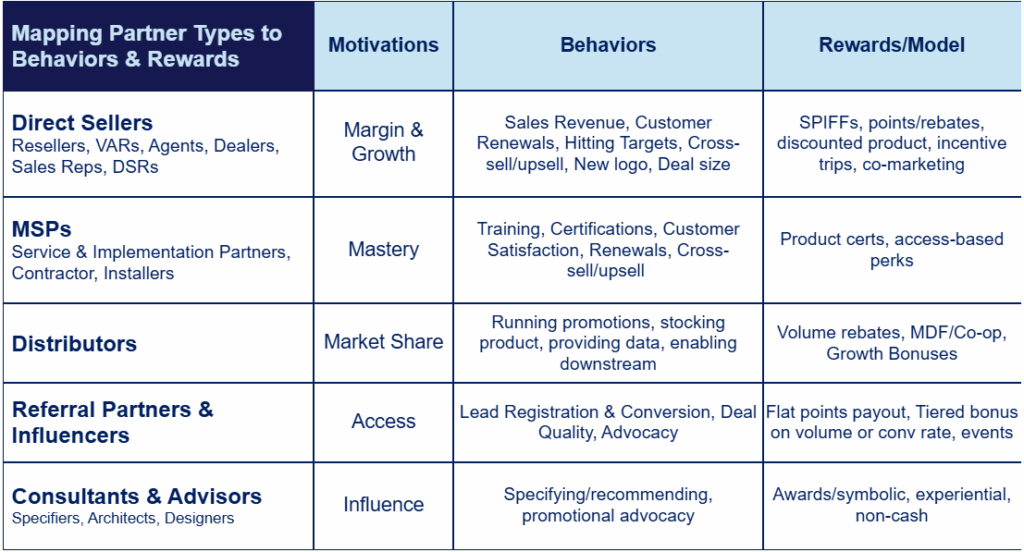
The Burning Question
How Do You Build an Incentive Program That Motivates Every Partner Type?
The Quick Answer
A successful partner incentive program motivates each partner type based on the unique value they bring. That means moving beyond one-size-fits-all rebates and designing flexible frameworks with points, cash and non-monetary rewards that recognize resellers, MSPs, distributors, referral partners, contractors and more.
The Partner Motivation Challenge
Whether you’re a technology provider, manufacturer or service company, you’re likely working with dozens of different partner types from resellers and distributors to MSPs, referral partners, influences and GSIs. These partners all have unique business models, sales cycles and motivations.
But here’s the problem: most incentive programs still treat all partners the same. The result? Engagement drops, high-value behaviors go unrewarded and you program fades into the background while competitors win attention.
Let’s explore how you can fix the one-size-fits-all problem by designing incentive programs for different partner types.
Why Do Different Partners Need Different Incentives?
Each partner contributes value differently:
- Resellers/VARs drive volume and margins.
- MSPs/Implementation partners build long-term stickiness through service and renewals.
- Referral partners open doors and connect you with leads.
- Distributors widen your reach, stock product and support downstream sellers.
- Advisors/Specifiers/Influencers shape buying decisions, even if they don’t close the deal themselves.
Real World Examples
Technology
An MSP may look like a transactional partner, but their business model is built around recurring services, and their true value lies in customer retention. A one-time rebate might get their attention at first, but incentives tied to renewals or satisfaction scores are aligned to their business and will keep them engaged year over year.
Manufacturing
A roofing distributor may hit sales quotas easily, but their value multiplies when they actively promote your brand to contractors. Rewarding them for stocking depth or marketing fund utilization ensures they don’t just sell but prioritize you over competitors.
Why Points Work: Points are flexible enough to serve many needs. They can be redeemed for cash equivalents, product certificates, in-kind vouchers, merchandise items, training certification, business reinvestments, or even travel. Points allow you to collapse multiple incentive streams into one wallet. A universal currency makes one framework work across dozens of partner types.
Handling Multi-Partner Deals Fairly: Everyone Deserves Recognition
It’s common for several partners to touch the same deal. A referral source makes the intro, a marketplace transacts, a VAR integrates and an MSP manages the client. So who gets credit? If only the transacting partner gets recognized, other valuable contributors are left out. That’s a fast path to disengagement.
Best Practice: Use role weighting and attribution logic in your platform to allocate rewards across all contributors. Even if the split isn’t perfect (say, 50% reseller, 30% referral, 20% marketplace) A fair model allocates recognition across all three.
Because even imperfect recognition is better than partners feeling invisible.
Keep It Simple for Partners (Even if It’s Complex Behind the Scenes)
So what’s the top question every program owner faces?
The Question: “How do I build a model that’s fair across different partner types without creating a monster that nobody understands?”
The answer: A simple, core framework with flexible options.
Your partners don’t want to read a rulebook. They want to know, “How do I earn rewards?” Make it easy for them to see their progress and understand what actions matter. We recommend using points-based frameworks to unify diverse earning rules:
- Resellers earn points on margin and deal size.
- Referral partners earn points for qualified leads.
- MSPs earn points for certifications and renewals.
- Contractors/installers in manufacturing earn points for completing training or promoting your new products
One currency, many ways to earn.
The front-end looks simple. Partners just see points piling up. Any complexity stays hidden in the background. That way, you get nuanced recognition without overwhelming the partner.
Instant Insight: Our recent report found that simplicity was one of the four most critical traits of successful incentive programs. Learn more here.
Which Rewards Work Best? Cash vs Points
The best incentive programs balance company-level rewards with individual-level motivation.
- Cash works best for the business entity: rebates, margin, short term cash SPIFFS, etc.
- Points work best for individual sellers, engineers or other teams that support the sale. Points also work great for non-transacting partners.
Real World Examples
Building Materials
A building materials manufacturer can reward distributors with quarterly rebates while giving points to frontline contractor sales reps for promoting their brand on job sites. The distributor will grow marketshare and the reps have a reason to actively push the brand in daily conversations.
Telecom
A telecom provider might pay rebates to the partner company but award points to individual reps for cross-sell activity. That dual approach grew the business relationship and drove rep-level behavior.
Examples of Non-Monetary Incentives for Partner Programs
Here’s the insider insight: partners don’t just care about payouts. They also value access, influence, enablement and recognition.
That’s why we recommend thinking in terms of five types of rewards:
- Monetary (rebates, SPIFFs)
- Symbolic (awards, recognition, prestige)
- Access (executive briefings, roadmap previews, beta access)
- Tangible (product credits, merchandise, swag)
- Experiential (training, workshops, incentive travel)

Do non-monetary incentives really work?
When you have multiple reward types incorporated into your program, you gain the flexibility to activate them uniquely across different partner types based on what they value.
Technology
Example: A tech company might give top MSPs executive access passes, granting them priority entry to executive briefings and roadmap previews. MSPs value this because it can open up growth opportunities for them and they walk away thinking “We don’t just resell their products, we’re building the future with them.”
Manufacturing
Example: For contractors, the manufacturer hosts hands-on installation clinics with direct specialist support. Contractors completing advanced training earn certificates to differentiate themselves in bids. The manufacturer also recognizes standout partners at an annual event, highlighting their achievements among peers and industry leaders.
This is loyalty in action. It’s not just about keeping partners happy. It’s about protecting mindshare when they’re juggling multiple vendor programs.
Building a Partner Incentive Behavior Matrix
To operationalize all of this, build a table that maps partner types to the behaviors you want to incentivize. Consider their motivations and business goals, what valuable actions they contribute and what rewards make sense. Check out this simplified example to get an idea of what your version could look like:

Let’s break down how different partner types are motivated and what incentives work best for each.
Reseller Incentives
What are the best incentives for MSPs?
Managed Service Providers (MSPs) and Implementation Partners succeed by delivering long-term customer outcomes. Their business model is built around retention and renewals. Incentives tied to certifications, contract renewals and customer satisfaction score keep them engaged. Non-monetary rewards like roadmap access or dedicated support also signal partnership value.
Distributor Incentives
What are the best incentives for distributors?
Distributors amplify your reach and influence partner adoption downstream. The right incentives reward stocking depth, effective use of MDR (market development funds) and proactive channel enablement. Rebates, tier-based bonuses and co-marketing opportunities are effective motivators.
Referral Partner Incentives
What are the best incentives for referral partners?
Referral Partners generate leads and open door to opportunities you wouldn’t reach otherwise. Since they don’t close deals, their incentives should reward qualified leads, pipeline influence and conversion quality. Simple points-based systems or flat-fee payouts per qualified lead keep the model clear and attractive.
Consultant/Influencer/Specifier Incentives
What are the best incentives for consultants and influencers?
Advisors, consultants, specifiers and influencers often shape brand preference before a purchase decision is made. Their impact is indirect but powerful. Incentives that reward advocacy, project specifications or inclusion in bid packages encourage them to champion your brand. Recognition, professional development opportunities and prestige-based rewards often matter more than pure cash.
How Technology Helps
Once you’ve mapped the right incentives to each partner type, the platform becomes the hub where it all comes to life. It’s the partner’s primary touchpoint with your program. The portal where a reseller checks their progress toward margin goals, an MSP tracks certification milestones, or a distributor sees how their stocking depth impacts rewards.
That’s why your partner incentive platform should do more than just “run the program.” It should support role-based experiences, tailored dashboards, and flexible reward paths so each partner type feels like the program was built for them.
FAQ: What features should a partner incentive platform include?
At minimum, look for features like:
- Progress tracking: so partners can see exactly where they stand and what’s next.
- Automated communications: to keep the program visible without constant manual effort.
- Flexible rules engine: to accommodate different earning paths and partner models.
- Fair attribution logic: so credit goes where it’s due, even in multi-touch deals.
- Reward options: a mix of individual and business rewards that fit your partners’ needs.
Key Takeaways: Incentives That Drive Partner Loyalty
- Design incentives that match the unique value of each partner type.
- Use simple, flexible frameworks so partners know how to earn rewards.
- Recognize every contributor in multi-partner deals.
- Balance cash and points to motivate both companies and individuals.
- Include non-monetary rewards like access, recognition, and enablement.
- Make progress tracking easy and transparent.
And if you remember one thing, let it be this:
Design incentives around the unique value each partner type creates. That’s how you grow engagement and loyalty across a diverse partner ecosystem.


